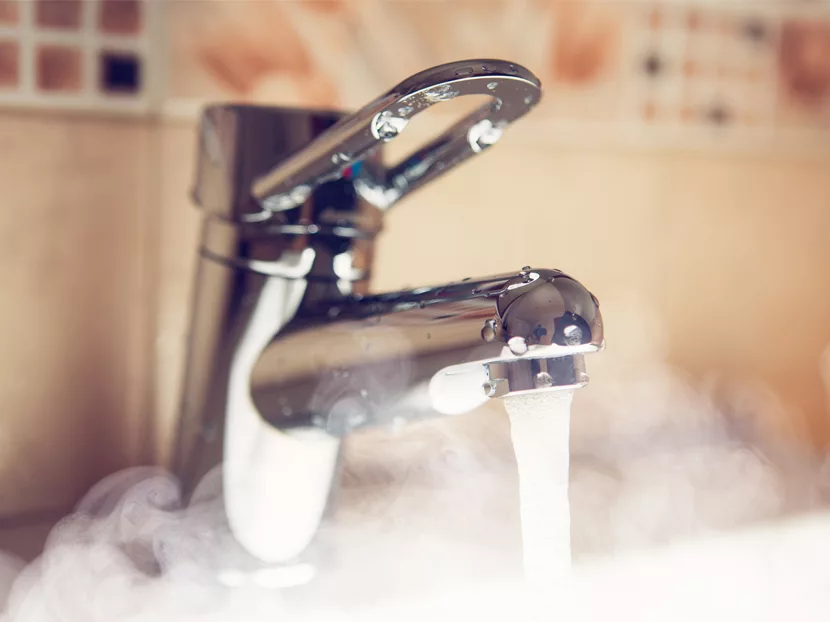Up until recently, there have been no accurate temperature control standards for water heaters. Now, the plumbing and heating industry has three new water heater temperature control standards, but not all water heaters are required to meet these standards.
The new water heater temperature control standards are:
1. ASSE 1082 Standard: Performance Requirements for Water Heaters with Integral Temperature Control Devices for Hot Water Distribution Systems;
2. ASSE 1084 Standard: Performance Requirements for Water Heaters with Temperature Limiting Capacity;
3. ASSE 1085 Standard: Performance Requirements for Water Heaters for Emergency Equipment.
The product descriptions for these standards on the ANSI webstore state:
• ASSE 1082-2018: “This standard covers water heaters with defined setpoint controls under various steady-state flow conditions. ASSE 1082 is for water heaters that control the outlet temperature to specific limits and are installed within a hot water distribution system but not at point-of-use.
“The water heater shall consist of a heat exchanger, a cold water inlet connection, a hot water outlet connection and a means for precisely governing the outlet temperature. The water heater controller shall be listed to the appropriate electrical safety standard in accordance with the water heater category.
“These devices are not intended for end-use applications without point-of-use control valves, as specified by ASSE 1016/ASME A112.1016/CSA B125.16, ASSE 1069, ASSE 1070/ASME A112.1070/CSA B125.70, or other appropriate standards.”
• ASSE 1084-2018 (ANSI-approved February 2019): “Water heaters with precise output temperature control under varying flow conditions are used to provide tempered water to the user. As such, they need to limit maximum water temperature at the point of use in order to reduce and control the risks of scalding.
“ASSE 1084 is intended to provide a level of scald protection consistent with the current ASSE 1070/ASME A112.1070/CSA B125.70, Performance Requirements for Water Temperature Limiting Devices. These water heaters are not intended to limit thermal shock and are not substitutes for automatic compensative valves complying with ASSE 1016/ASME A112.1016/CSA B125.16, Performance Requirements for Automatic Compensating Valves for Individual Showers and Tub/Shower Combinations.”
• ASSE 1085-2018 (R2021): “This standard covers water heaters with precise setpoint controls under varying flow conditions. ASSE 1085 is for water heaters supplying tepid water to emergency equipment, including eyewash, eye/face wash, emergency showers and combination units. These water heaters heat the cold water supply to an acceptable tepid temperature within the intended range listed in ISEA Z358.1.
“The water heaters shall consist of a cold water inlet connection, a means of heating the water and controlling the discharge temperature, and an outlet connection to supply tepid water to the emergency equipment. The water heater shall also have a means to limit the maximum outlet temperature under normal operating conditions. Provisions shall be made so that the temperature setting of the water heater cannot be inadvertently adjusted.”
How Did the Control Standards Come About?
In early 2014, a tankless electric water heater manufacturer reached out to me, asking for my assistance with testing his product to the standard ASSE 1070: Temperature Limiting Devices. He explained that his product is intended to be a small, point-of-use water heater that is a temperature-limiting device. It had very sophisticated electrical controls built into the unit, which eliminated the problems of over-temperature and thermal shock.
The manufacturer saw his product used for limiting the temperature of the hot water supply to sinks and lavatories, similar to ASSE 1070 devices. However, instead of adding a separate mixing valve to mix cold water with hot water, the unit would receive cold water and limit the heat input to control the hot water temperature produced.
He read the scope and requirements of the ASSE 1070 temperature-limiting standard, and believed his product could meet or exceed its requirements, as written in its scope.
I reviewed the scope and testing procedures of the ASSE 1070 standard to see if his electric point-of-use water heater could be considered a temperature-limiting device. I agreed it was a temperature-limiting device, but that the ASSE 1070 standard was originally intended to be a mixing valve standard.
In 2014, the most recent edition of the ASSE 1070 standard was the 2012 edition. The scope read as follows:
“ASSE 1070
“Performance requirements for water temperature limiting devices.
“Section I
“1 Scope
“Water Temperature Limiting Devices (herein referred to as the ‘device’) shall limit the water temperature to fittings for fixtures such as sinks, lavatories or bathtubs and are intended to reduce the risk of scalding.”
The design requirements of the 2012 ASSE 1070 standard specified a cold water and a hot water inlet. Section III, Design and General Requirements, Section 3.1.3 Temperature Range provides that the “device shall operate with inlet cold water temperatures … and with inlet hot water temperatures.”
Also, the various testing procedures made clear that both a cold water and a hot water inlet were intended and required for devices that met the ASSE 1070 standard. The manufacturer stated his electric tankless water heater only had a cold water inlet and didn’t need hot water to be supplied to it. Rather, his device heated cold water, and the controls would shut down before the outlet temperature could exceeded 120 F, or whatever temperature setting was desired (within the tolerance range in the 1070 standard).
I informed the manufacturer of his options:
1. Request a lab to test his tankless electric water heater to the ASSE 1070 standard, as is;
2. Request a lab to test his tankless electric water heater to a modified version of the ASSE 1070 standard;
3. Request a modification of the ASSE 1070 standard to allow his product to be tested to it;
4. Request development of a new standard for a temperature-limiting water heater.
I presented the tankless heater manufacturer’s request to test his product to ASSE 1070 as a temperature-limiting device to the ASSE Product Standards committee; it recommended that the manufacturer file a request for the development of a new ASSE Product Standard. After the request for a new product standard was made by the manufacturer, the standards development procedure (established under ANSI) ensued, and a public notice to develop a new water heater temperature control standard was published.
This new water heater standard request resulted in much interest from many water heater manufacturers. By early 2016, a large working group for ASSE 1082 was established, many of whom did not have tankless heaters, and the first draft of a new industry standard for water heaters with integral temperature controls was developed. It followed the temperature control requirements in the ASSE 1017 standard for temperature-actuated mixing valves for hot water distribution systems.
Before the development of this new standard, I had heard that some tankless heater manufacturers were already promoting their products as temperature-limiting devices. Also, some inspectors were letting such products be installed as temperature-limiting devices, though some inspectors were yet requiring ASSE 1017 or ASSE 1070 mixing valves to be installed downstream of the tankless water heaters.
ASSE 1082
The first standard in development was given the number 1082. Development of the ASSE 1082 standard strayed away from the tankless water heater manufacturer’s original intent and application for his product: to be used as a point-of-use, temperature-limiting water heater performing the same function as ASSE 1070 temperature-limiting devices.
Instead, what developed was a new temperature control standard for a water heater serving a building’s hot water distribution system. The scope of ASSE 1082-2018 was written as:
“This standard is for water heaters that control the outlet temperature to specific limits and are installed within a hot water distribution system but not at point-of-use.”
Its description was written as:
“The water heater shall consist of a heat exchanger, a cold water inlet connection, a hot water outlet connection, and a means for precisely governing the outlet temperature. The water heater controller shall be listed to the appropriate electrical safety standard in accordance with the water heater category.”
The ASSE 1082 standard, intended for hot water distribution systems, is not for scald prevention. For example, a “distribution” water heater, meeting the ASSE 1082 standard, could not be used to prevent scalding in large buildings due to the potential for significant temperature drops throughout the distribution piping. The hot water temperature delivered to each branch will be different depending on its location in the system (heat loss between the source and each fixture).
In addition, there are Legionella bacteria growth concerns. According to ASHRAE Guideline 12-2020: Minimizing the Risk of Legionellosis Associated with Building Water Systems and ASHRAE Standard 188-2018, Legionellosis: Risk Management for Building Water Systems, the end of hot a water distribution system’s (hot water return pump) temperature should be kept above the Legionella growth temperature range (above 122 F).
Assuming a 2-degree safety factor is used on the hot water return, the return temperature would be 124 F, with a 10-degree drop in the system’s circulated loop; the supply temperature from an ASSE 1082 water heater would need to be 134 F at minimum. With a 20-degree temperature difference in the system’s circulated loop, the supply temperature into the hot water distribution system would need to be a minimum of 144 F.
Many tankless electric or gas heaters would struggle to provide this temperature and would not last very long in a circulated system.
As a side note, I have seen a trend for building owners to use water treatment chemicals for controlling and/or disinfection of systems from Legionella. The levels of water treatment chemicals needed to disinfect a system can be corrosive to the plumbing system, including water heater parts and gaskets. Water heater manufacturers should consider including a corrosion-resistance test for these common disinfection chemicals used for control of microorganisms in plumbing systems: chlorine, monochloramine, chlorine dioxide, ozone and copper/silver ionization, etc.
The test should consider the time it takes to get the chemicals flushed through the heater and out of the fixtures at remote locations before the contact time at elevated chemical levels begins on the disinfection. ASSE should consider a water treatment chemical resistance test for all standards.
Since the ASSE 1082 standard “covers water heaters with defined setpoint controls under various steady-state flow conditions,” some models may meet the ASSE 1082 standard yet may still require a downstream ASSE 1017/1070 mixing valve in order to ensure a stable hot water distribution temperature during variable-flow conditions.
In a real-world distribution system, flows will change as other fixtures are turned on and off. It is also widely understood that changes in flows through a tankless water heater will cause fluctuations in the outlet temperature; some product manufacturers have incorporated sophisticated controls to account for this flow variability.
However, the ASSE 1082 standard tests at steady-state flows. It does not differentiate between products with sophisticated controls from those with simple energy on/off functions, and it does not test for temperature control stability under variable-flow conditions.
ASSE 1084 and ASSE 1085
Because the ASSE 1082 standard was not appropriate to the original tankless heater’s manufacturer desired application, he requested the development of a new standard for a water heater with temperature-limiting capabilities equivalent to that of ASSE 1070. This resulted in the development of ASSE 1084, which is a standard for point-of-use, temperature-limiting water heaters.
At that time, there also was a proposal to develop a new standard for a temperature-limiting water heater for emergency equipment (eye washes, emergency showers, etc.). The result was ASSE 1085, using ASSE 1071: Performance Requirements for Temperature Actuated Mixing Valves for Plumbed Emergency Equipment, as a guide.
The foreword of the ASSE 1084 (2018) standard provides:
“This standard is intended to provide a level of scald protection consistent with the current ASSE 1070/ASME A112.1070/CSA B125.70 requirements for temperature-limiting devices. The technology of heater controls has come a long way over the past several years regarding precise modulation of heat output that directly resembles, improves, or outperforms other devices due to transient temperature drops. A downstream mixing valve would no longer be necessary.”
The description of ASSE 1084 provides:
“1.2 Scope
“1.2.1 Description
“Water heaters covered by this standard have a cold water inlet connection, a means of heating the water, a means of controlling the water temperature, a means of limiting the temperature to a maximum of 120 F (48.9 C), and have an outlet connection to connect to downstream fixture fittings. This water heater is intended to supply tempered water at point of use in order to reduce and control the risks of scalding. This water heater is not intended to limit thermal shock. This water heater is not a substitute for an automatic compensating valve complying with ASSE 1016/ASME A112.1016/CSA B125.16.”
Beginning with the 2021 International Plumbing Code (IPC), ASSE 1082 and ASSE 1084 devices are identified as an option for a water temperature-limiting device for bathtubs and whirlpool bathtubs (in addition to ASSE 1070). ASSE 1082 devices are provided as an option for head shampoo sink faucets (in addition to ASSE 1070 and ASSE 1062), and as an option for footbaths and pedicure baths (in addition to ASSE 1070).
The 2021 Uniform Plumbing Code (UPC) allows ASSE 1084 devices as an option for limiting the hot water temperature at bathtubs/whirlpool bathtubs, bidets, individual showerheads and public lavatories. There are differences between the 2021 IPC and the 2021 UPC in the sections on limitation of hot water temperature at various fixtures, so each code should be individually reviewed.
However, neither code limits the maximum hot water temperature for sinks and lavatories, though the manufacturer had envisioned his product being used for limiting the temperature of the hot water supply to sinks and lavatories.
The codes still require gas-fired, storage-tank-type water heaters to be listed in accordance with ANSI Z21.10.1/CSA 4.1 (gas water heaters, volume I, storage water heaters with input ratings of 75,000 BTU/hour or less) or ANSI Z21.10.3/CSA 4.3 (gas-fired water heaters, volume III, storage water heaters with input ratings above 75,000 BTU/hour, circulating and instantaneous). (See Section 502.1, IPC (2021) and Section 624.1, 2021 International Fuel Gas Code.)
Water heaters meeting these standards provide hot water to a massive portion of the population; in the United States alone, more than 4 million tank-type water heaters are shipped annually. Water heaters covered by both standards are for use with natural gas, manufactured gas, mixed gas, liquefied petroleum (LP) gases and LP gas-air mixtures.
This also includes recreational vehicle installation for use with LP gases only; mobile home and recreational vehicle installation, convertible for use with natural LP gases when provision is made for the simple conversion from one gas to the other; and combination potable water/space-heating applications.
Gas-fired, storage-tank-type water heaters can experience significant temperature rises above the thermostat setpoint under normal operating conditions — up to 30 F — and there is no requirement that the outlet temperature be within any reasonable degree of the thermostat setpoint during intermittent use of hot water.
For example, in the ANSI Z21.10.1/CSA 4.1 Standard (2009), the only temperature test is to ensure the outlet temperature is no more than 30 F above the temperature of the water inside the tank at thermostat level, when the thermostat is adjusted against its high stop, for water heaters intended to deliver water at a temperature not in excess of 160 F. Or the outlet temperature is no more than 20 F for water heaters intended to deliver water in excess of 160 F.
ASSE 1016 and ASSE 1017
For many years, the codes expressly prohibited the thermostat dial on the water heater from being used as a final control for purposes of scald protection. Because of the inherent temperature fluctuation with uncirculated tank-type water heaters, ASSE has a temperature-actuated mixing valve standard — ASSE 1017: Temperature Actuated Mixing Valves for Hot Water Distribution Systems. It is designed to provide a relatively stable hot water temperature for delivery to the hot water distribution system.
ASSE 1017 temperature-actuated mixing valves should be adjusted to maintain a minimum temperature of about 124 F at the coolest point in the hot water distribution piping and hot water return system (after the circulating pump, just before connection to the water heater) to keep the lowest temperature in the hot water distribution system at least a couple degrees above the upper Legionella bacteria growth temperature of 122 F.
Separately, for individual shower and tub-shower applications, the valves listed in ASSE 1016: Individual Thermostatic, Pressure Balancing and Combination Pressure Balancing and Thermostatic Control Valves for Individual Fixtures must be installed and properly adjusted to reduce the maximum (mixed) hot water temperature delivered from bathtub spouts and showerheads to 120 F or less.
Ideally, ASSE 1016 valves should be set to a maximum temperature of 110 F or less where children, the elderly or people with disabilities are present; the potential for scalding would be virtually eliminated.






